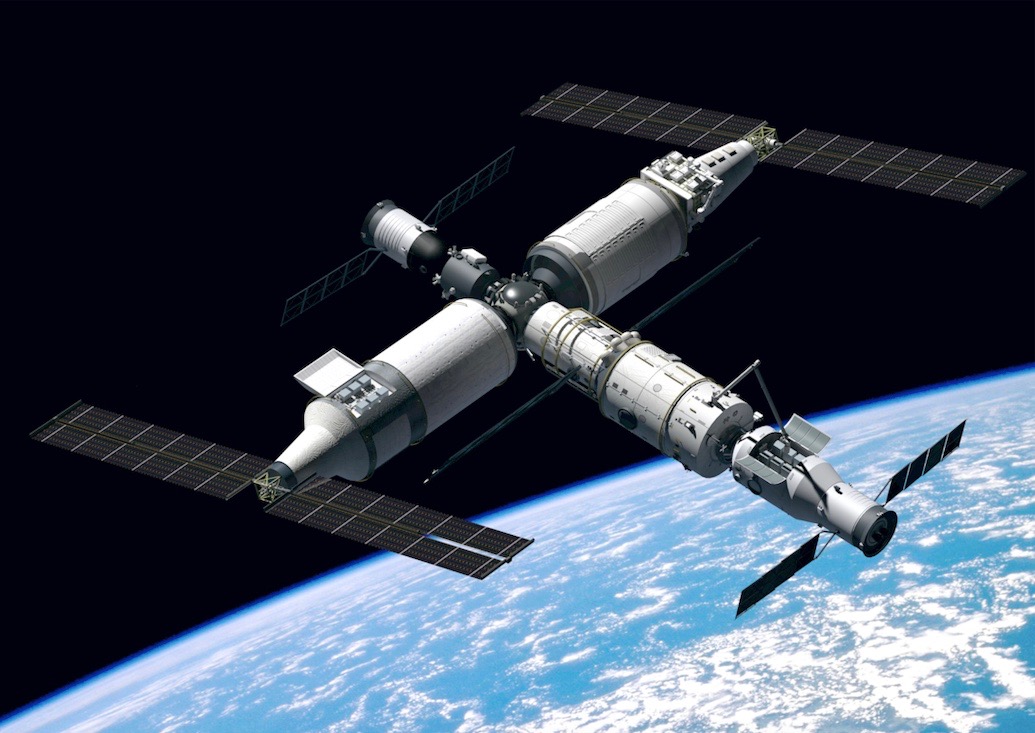China aims to complete space station, break launch record in 2022
The country intends to build on its recent space successes.

China is aiming to eclipse a new national launch record set last year while also completing its three-module space station with six related missions in 2022.
The China National Space Administration is preparing to launch two new space station modules, named Wentian and Mengtian, on separate Long March 5B rockets in the coming months.
The modules will dock with the Tianhe core module, launched in April 2021, to complete the T-shaped Tiangong space station before the end of the year.
Related: The latest news about China's space program
Preparations for both missions are advancing well. The third Long March 5B rocket has completed the final assembly and testing and will launch Wentian near the middle of the year. The fourth Long March 5B Y4 is undergoing final assembly and will launch Mengtian in the second half of 2022, according to the China Academy of Launch Vehicle Technology (CALT).
The two modules have a mass of more than 44,100 pounds (20,000 kilograms) each, and are primarily designed to host science experiments. Wentian also has new airlock facilities for extravehicular activities, or spacewalks, and will add a second, smaller robotic arm to the space station.
A large robotic arm on the Tianhe will grab and move the new modules into position after they dock with Tianhe.
Get the Space.com Newsletter
Breaking space news, the latest updates on rocket launches, skywatching events and more!
"After the T-shaped structure is formed, we will fully test the functions and performances of the space station as a whole. We estimate that the space station will enter the operation phase at the end of the year,” Bai Linhou, space station system deputy chief designer at the China Academy of Space Technology (CAST), told CCTV.
Video: Watch China's Tiangong station robotic arm move in space
Wentian, or experiment module I, will serve as the backup of the Tianhe core module to improve the reliability and redundancy of the space station.
China will also launch two Tianzhou cargo spacecraft and two Shenzhou crewed missions as part of six space station missions planned for 2022.
Overall China is planning to launch 140 spacecraft on more than 50 launches in 2022, according to the China Aerospace Science and Technology Corporation (CASC), which owns CAST and CALT. CASC launched 48 Long March rockets in 2021.
Other notable missions include a second launch of the Long March 8, without side boosters, from Wenchang, and the first launch of the Long March 6A. China’s commercial and private launch companies will also contribute to the rapid launch rate.
Late 2022 is expected to see China’s first crew rotation when two crewed spacecraft will be in orbit at the same time. Shenzhou 15 will launch and dock with Tianhe late in the year, joining the crew of Shenzhou 14 onboard. This will mean China will have six astronauts in orbit at the same time.
There’s also good news for the crew of the ongoing Shenzhou 13 mission. Astronauts Zhai Zhigang, Wang Yaping and Ye Guangfu will perform the first “rapid” return to Earth in a Shenzhou, which means the crew should land just a few hours after undocking from Tianhe, rather than spending 24 hours or more aboard their Shenzhou return capsule.
Shenzhou 13 launched on a Long March 2F from Jiuquan Satellite Launch Center on Oct. 16, 2021. Another Long March 2F, the 14th in the series, has been in a state of near readiness in case of an emergency aboard Tianhe.
Assuming the Shenzhou 13 mission is completed safely, around March or April, the 14th Long March 2F will later launch Shenzhou 14, following delivery of supplies aboard the Tianzhou 4 cargo spacecraft.
The 15th Long March 2F will then be prepared at Jiuquan for emergency standby. "The Y15 rocket is undergoing testing for final assembly in the workshop, and it will be transported to the Jiuquan Satellite Launch Base for the launch mission after all the jobs are done," Jing Muchun, a chief designer of the Long March 2F, told CCTV.
Follow us on Twitter @Spacedotcom and on Facebook.
Join our Space Forums to keep talking space on the latest missions, night sky and more! And if you have a news tip, correction or comment, let us know at: community@space.com.

Andrew is a freelance space journalist with a focus on reporting on China's rapidly growing space sector. He began writing for Space.com in 2019 and writes for SpaceNews, IEEE Spectrum, National Geographic, Sky & Telescope, New Scientist and others. Andrew first caught the space bug when, as a youngster, he saw Voyager images of other worlds in our solar system for the first time. Away from space, Andrew enjoys trail running in the forests of Finland. You can follow him on Twitter @AJ_FI.









